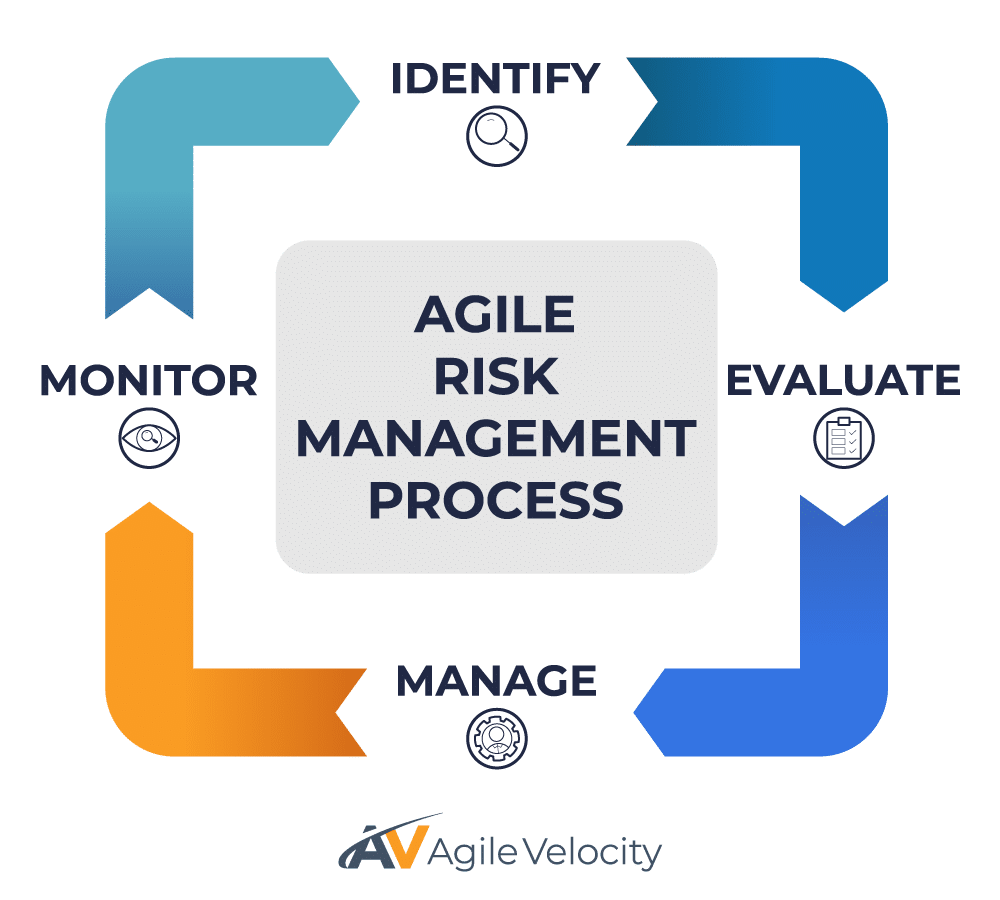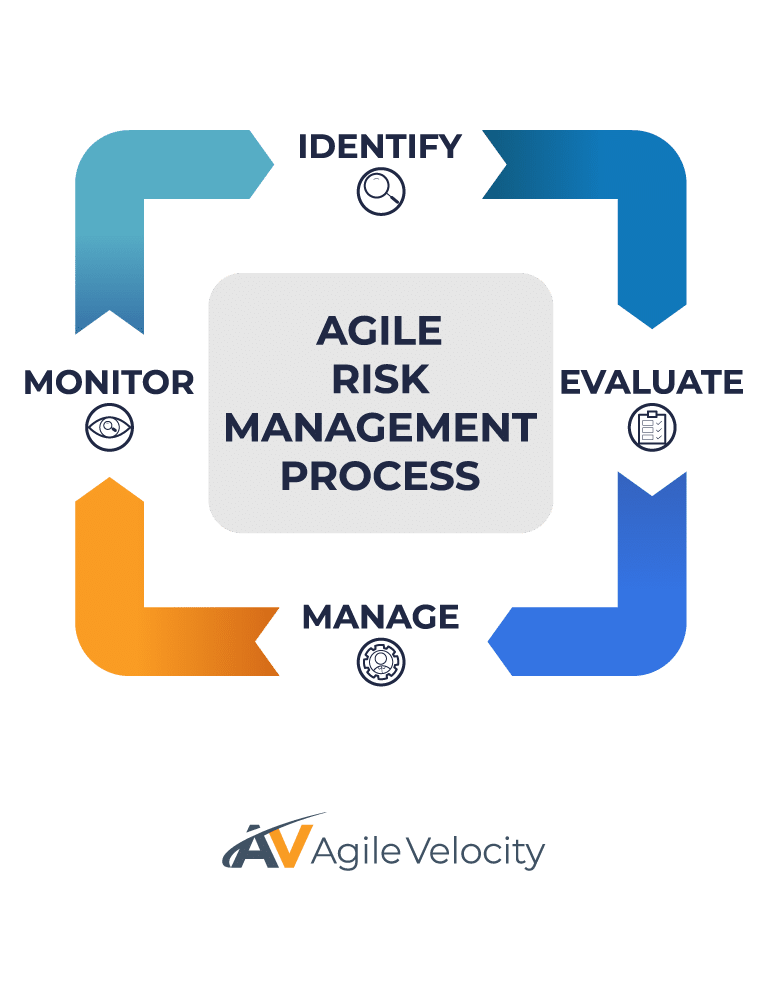Digital transformation demands balancing speed, quality, and adaptability in unpredictable environments. Rapid technological advancements and compressed delivery timelines heighten risks, potentially leading to costly setbacks. Digital transformation best practices that can help teams approach uncertainty with confidence. In these scenarios, Agile risk management can be highly effective, particularly in projects with high uncertainty and complexity.
Agile frameworks replace rigid, upfront plans with iterative cycles, enabling teams to uncover and address risks early. Through shorter feedback loops and continuous delivery, Agile allows quicker responses to challenges, ensuring that risks are not overlooked. This article explores how Agile practices empower teams to manage risks in dynamic environments and how tools like Path to Agility® Navigator enhance visibility and accountability.
This guide highlights core components of effective risk management in Agile projects, from iterative delivery and continuous integration to collaborative scaling strategies. By managing risks early, organizations can turn digital transformation complexities into opportunities for innovation and growth. Let’s explore why risk management is vital to Agile project delivery and strategies to help your teams succeed.
Risk Management in Agile Project Delivery
At its core, risk management involves identifying, evaluating, and responding to potential obstacles that could disrupt a project’s success. Agile project delivery offers a distinct advantage by transforming traditional risk management into a more organic, embedded process. By integrating regular checkpoints and continuous feedback cycles, Agile teams address issues proactively rather than reactively.
Why Agile Sets the Stage for Better Risk Management
Agile frameworks like Scrum and Kanban operate on iterative, incremental cycles—referred to as Sprints or Iterations. This structure limits the amount of work at a time, reducing the likelihood of risks escalating. In Scrum, each Sprint concludes with a tangible deliverable called the Increment. This frequent delivery ensures that risks, whether technical or operational, surface early before they snowball into larger problems.
Balancing Speed and Risk in Digital Projects
In digital transformation, organizations often face pressure to deliver value quickly to stay competitive. However, moving too fast can lead to overlooked risks, quality issues, and team burnout. Agile approaches offer a balanced path by emphasizing smaller increments of value while continuously addressing potential hazards.
This iterative mindset shifts away from detailed upfront plans, embedding risk awareness into regular events and feedback loops. Processes like the Daily Scrum and Sprint Retrospective allow for ongoing monitoring of progress, enabling teams to pivot rapidly when risks are identified. By prioritizing open communication and short delivery cycles, teams keep risks manageable and maintain momentum.
The Role of Risk Management in Digital Transformation
Digital transformation demands a shift in how organizations operate, collaborate, and deliver value. Embracing these changes introduces evolving risks—such as hidden technical dependencies or resource constraints—that can derail initiatives without proper management.
Tackling New Complexities and Emerging Risks
Modern digital projects often involve advanced features, AI solutions, or large-scale system integrations. These can introduce unique uncertainties, including data reliability and underexplored technical requirements. Agile practices prioritize testing early “proofs of concept,” allowing teams to validate assumptions and mitigate risks before moving to full-scale implementation.
By delivering value in smaller iterations and validating deliverables against user needs, Agile teams uncover hidden issues more quickly. Whether it’s an integration problem or stakeholder misalignment, the frequent checkpoints offered by Agile methods help to surface and address potential pitfalls while there’s still time to adjust.
How Organizational Agility Reduces Digital Risks
Traditional, linear project management often struggles with the unpredictable demands of digital transformation. By embracing organizational agility, teams gain the ability to respond to evolving risks and shifting priorities with greater speed and effectiveness. Instead of committing to static, upfront plans, Agile teams take an iterative approach—breaking work into smaller packages to assess feasibility and alignment frequently.
Each Sprint or Iteration becomes an opportunity to adjust to new insights. If user feedback reveals a feature is misaligned with market expectations, teams can reevaluate priorities and redirect efforts before more resources are spent. This adaptability reduces the chance of wasted effort or misallocated budgets, allowing organizations to remain responsive to challenges throughout the transformation journey.
Agility as Risk Reduction
Digital initiatives inevitably involve unknowns. With the right Agile mindset, organizations can treat these unknowns as opportunities to learn. Frequent delivery, open collaboration, and prioritized feedback loops reduce the time it takes to spot and respond to risks.
Agile isn’t about eliminating risks entirely—it’s about reducing uncertainty and enabling quick pivots. Through frequent iteration and constant feedback, organizations can keep digital initiatives on course, delivering meaningful results. Tools like Path to Agility Navigator enhance this impact by offering improved visibility and alignment across the transformation journey, making risk management not just a protective mechanism, but also a driver of success.
Core Components of Agile Risk Management Practices
Agile brings built-in operating models that help teams recognize and mitigate risks. By focusing on shorter cycles, frequent feedback, and adaptive planning, Agile creates an environment where potential problems are identified and addressed before they escalate.


Iterative Delivery: Spot Risks Early, Adapt Quickly
Iterative delivery is the cornerstone of Agile, enabling teams to break work into smaller, testable increments. This allows risks to surface early. For example, rather than waiting until the end of a project for a system integration, Agile teams deliver and validate a portion of the functionality each Sprint. Any incompatibilities or performance issues become apparent quickly, enabling immediate course corrections.
Continuous Integration: Catch Issues Before They Escalate
Continuous integration is a practice in which code is frequently merged into a shared repository. Each integration triggers automated builds and tests, highlighting any conflicts or defects in near real-time. By detecting issues early, teams decrease the likelihood of major setbacks when expanding the codebase or finalizing product features.
Agile Events: Built-In Risk Management Sessions
Agile’s recurring events double as opportunities to surface and address risks:
- Sprint Planning helps teams identify uncertainties within backlog items and plan how to address them.
- Daily Scrum (or Daily Sync) ensures that obstacles or risks are flagged immediately, keeping everyone aligned.
- Sprint Review provides a chance to gather stakeholder feedback, uncovering risks tied to delivery expectations or misaligned priorities.
- Sprint Retrospective allows teams to reflect on the Sprint, identifying recurring risks and areas for improvement.
These frequent, collaborative interactions keep the team focused on delivering value while addressing uncertainties as part of the workflow. The Scrum Master guides this process by removing impediments and ensuring the team remains proactive about tackling risks.
This structure ensures that risk management is woven into daily activities rather than treated as an afterthought.
Backlog Prioritization for Risk Mitigation
Backlog Prioritization helps Agile teams tackle the riskiest items first. By scheduling tasks that carry the greatest uncertainty early, teams gain rapid insight into potential obstacles. If a new feature is using unknown technology, addressing it upfront allows any issues to be resolved before they become costly bottlenecks. Ongoing backlog grooming ensures continuous visibility into emerging threats that need immediate attention.
Tools and Frameworks to Optimize Risk Management
Beyond standard Agile rituals, specialized tools and frameworks can further streamline risk management. By making progress visual and aligning it to organizational objectives, teams gain clearer pathways to recognize and manage risks collaboratively.
Map Risks and Progress with Path to Agility Navigator
Tracking and addressing risks can become overwhelming in cross-functional or enterprise-wide projects. Tools like Path to Agility Navigator can help teams visualize progress, highlight bottlenecks, and keep risks front and center, helping teams to facilitate swift action by bringing these issues to the attention of relevant stakeholders.
Achieve Alignment with Lean Portfolio Management
Lean Portfolio Management bridges the gap between strategic goals and daily execution. With frequent evaluations, organizations can align investment and resource allocation with high-value initiatives, adapt to market shifts, and reduce misdirected efforts. Prioritizing the most important work ensures Agile teams stay focused on delivering features that matter most, lowering the risk of investing in less impactful projects.
Visualize and Address Bottlenecks Using Kanban Boards
Kanban Boards offer a streamlined view of tasks, making potential bottlenecks impossible to ignore. When tasks accumulate in a particular step, it signals a capacity or process issue that can become a risk. By introducing Work In Progress (WIP) Limits, teams can prevent overload and force prioritization. This reduces risks tied to multitasking and hidden dependencies, preserving quality and predictability.
Predict Risks with AI-Driven Insights
Emerging AI tools can give Agile teams an edge in understanding potential pitfalls. By analyzing historical data or code patterns, AI solutions can forecast possible integration conflicts or highlight subtle feedback trends from end users. These insights allow teams to make preemptive changes, turning reactive fire drills into informed and timely risk mitigation steps.
The Importance of Transparency and Collaboration in Risk Management
Open communication and collaboration form the backbone of Agile risk management. When risks are shared freely and addressed collectively, the entire organization benefits from quicker resolutions and fewer surprises.
Open Communication: The First Step to Identifying Risks Early
A climate of transparency lets team members feel comfortable speaking up about concerns or uncertainties. Daily Scrums, for instance, give everyone a chance to flag potential problems or warn of delays. By surfacing issues daily, teams can respond before those issues escalate.
Building Trust to Strengthen Collaboration and Decision-Making
Effective collaboration is grounded in trust. When individuals trust their teammates, they’re more likely to voice doubts, propose adjustments, or admit mistakes promptly. Shared boards, regular syncs, and clear goals foster this collective mindset. In turn, risks are addressed by the best combination of skill sets, ensuring a balanced and efficient approach to problem-solving.
Risk as a Shared Responsibility
Agile’s emphasis on teamwork extends to risk ownership. Instead of delegating risk management to a single role, Agile encourages everyone—Scrum Masters, Product Owners, developers, and other stakeholders—to remain vigilant. This shared approach ensures faster responses, more creativity in solutions, and a greater sense of accountability across the entire project.
Scaling Agile Risk Management for Large Enterprises
As organizations grow, they often juggle multiple teams, portfolios, and product lines. Amid this complexity, scaling Agile risk management requires robust coordination, visibility, and shared accountability at every level.
Synchronizing Teams with SAFe® for Cohesion
SAFe® (Scaled Agile Framework®) offers a structured way to align teams around shared objectives while staying attentive to risks. The Agile Release Train (ART) groups multiple Scrum Teams, Product Owners, and Business Owners (BO) under common Planning Interval (PI) Objectives, creating focus on organizational outcomes. During PI Planning, participants examine potential hurdles, foster collective ownership of risks, and adjust priorities to maintain cohesion.
Managing Complexity with Scaled Frameworks
Beyond SAFe, frameworks like Large-Scale Scrum (LeSS) also provide guidelines for coordinating teams and reducing duplication. They emphasize transparency, collaboration, and frequent feedback. When scaled properly, these approaches ensure that risks are visible at all levels—allowing leaders to maintain strategic oversight while teams stay Agile on the ground.
Building Risk Resilience Across Teams
Resilience in larger organizations depends on a culture of openness, frequent inspection, and willingness to pivot. By combining frameworks that promote alignment with practices like Kanban Boards or Path to Agility Navigator for visibility, enterprises can detect and address risks before they undermine entire portfolios. This holistic, scaled approach keeps risk management consistent and effective, even in highly complex settings.
Learn About the SAFe® Framework
Continuous Improvement and Evolving Risk Strategies
Continuous improvement is an essential Agile principle that keeps risk strategies up to date. By regularly reviewing and refining practices, teams stay ahead of emerging challenges and innovate new approaches to prevention and mitigation.
Leveraging Retrospectives to Uncover Patterns
Sprint Retrospectives give teams dedicated time to discuss what went well and where improvements are needed. If a particular risk recurs Sprint after Sprint, retrospectives help the team identify root causes—like outdated documentation or excessive dependencies—and systematically address them.
Making Data-Driven Decisions
Metrics such as velocity or defect rates can provide early warning signals of risks that aren’t immediately obvious. When teams track these indicators, they gain deeper insights into problematic areas. This data-driven approach ensures decisions are grounded in evidence rather than assumptions.
Encouraging Real-Time Problem Solving
Agile teams thrive when they’re empowered to make decisions quickly. If a blocker threatens the Sprint Goal, a cross-functional team can collaborate immediately to find workarounds or pivot scope. Scrum Masters and Agile Coaches play a pivotal role by nurturing this environment of autonomy and trust.
Experimentation as a Tool for Evolving Strategies
Experimentation is key to continuous improvement. Testing small changes in processes, workflows, or tools allows teams to gauge effectiveness without risking the entire project. Over time, successful experiments become formalized best practices, driving ongoing progress toward better risk management.
Strategies for Balancing Speed and Risk Mitigation in Agile Delivery
A successful Agile approach requires balancing swift deliveries with deliberate risk controls. By embedding risk awareness throughout the process, teams can move quickly without compromising quality.
Deliver Smaller Increments to Isolate and Minimize Risks
Delivering smaller increments at the end of each Sprint or Iteration isolates potential issues. If one feature fails or needs rework, that failure is contained to just a slice of the project rather than the entire release. This segmentation supports rapid learning and lessens the likelihood of large-scale rework.
Leverage Data to Proactively Address Emerging Risks
By reviewing metrics like cycle time or defect counts, teams spot warning signs of potential pitfalls. Spikes in defects, for instance, may call for enhanced testing or deeper review of user stories. Addressing those issues promptly allows teams to stay on track while keeping risk at manageable levels.
Empower Cross-Functional Teams for Immediate Problem-Solving
Cross-functional teams combine a wide range of skill sets—allowing them to resolve most challenges without waiting for outside experts. If an unexpected integration conflict arises, the people needed to fix it are already on the same team, ensuring faster resolution and higher-quality outcomes.
Align Risk Management With Business Objectives
In Agile, prioritization is key. Teams should align high-risk, high-impact features to business goals so they receive the appropriate amount of attention. During Sprint Planning, understanding the business value of each backlog item ensures that work is ordered effectively, balancing speed with a proactive approach to managing uncertainty.
Embracing Agile Risk Management for Sustainable Digital Transformation

Agile practices offer a resilient way for teams to manage the challenges of digital transformation. By structuring work into Sprints or Iterations, including risk-related discussions in daily events, and integrating practices help teams stay nimble and keep problems contained before they grow.
When organizations treat risk management as a group effort, they become more adaptable in fast-paced environments. By fostering collaboration, transparency, and continuous improvement, teams mitigate challenges quickly and consistently deliver value. Agile principles unify everyone into tackling obstacles proactively rather than reactively, creating smoother deliveries and more reliable results.
As you look to optimize your Agile Transformation, refine processes, and improve business operations, consider partnering with experts who can guide you. If you’d like to learn how Agile Velocity can help accelerate your transformation, request a meeting to discuss your transformation needs. Embrace agility, reduce risks, and confidently navigate your digital change journey today.



